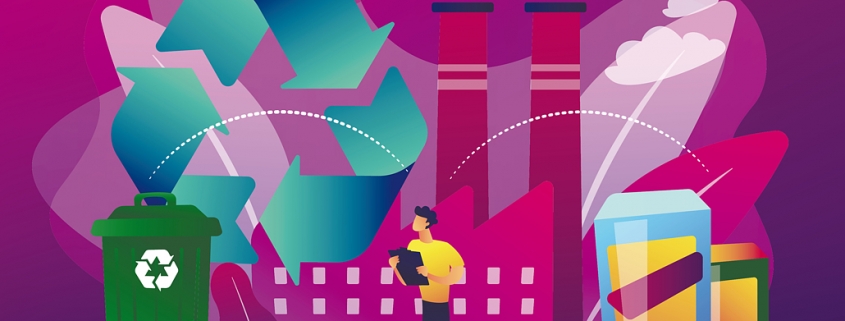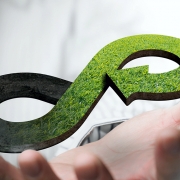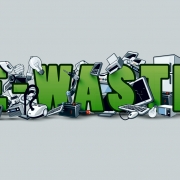Chemical Recycling of Plastic – Waste No More?
When it comes to the circular economy transition, plastics recycling is as much of a challenge as an opportunity. Today, around 25.8 million tons of plastic waste are generated in Europe every year, with less than 30 percent of it getting collected for recycling. This is a huge loss of valuable resources to the economy, and with a huge cost to the environment. Could chemical recycling be part of the ultimate solution, making the plastics value chain more circular whilst providing a profitable new industry branch.
Plastic pollution of the oceans, the resulting damage to wildlife, and the human health risks from microplastic have ignited public concern and heated discussions around plastic reduction. The decisions by China, Malaysia and soon Vietnam to stop imports of plastic waste, and growing public pressure have prompted the realization in Europe that exporting, burning and burying are not the right solutions to the smoldering plastic crisis. European and global approaches are needed to deal with the predicted doubling of the global production of plastic over the next 20 years fueled by increasing consumption, particularly in developing countries.
In the European Union, the Waste Framework Directive (WFD) and the Packaging and Packaging Waste Directive (PPWD) already demonstrate a common understanding that plastics waste should be recycled as much as possible. More explicitly, the EU Plastics Strategy stipulates that by 2030 all plastic packaging should be either reusable or easily recyclable. With new regulation and public concern on the rise, more than 70 industry associations and major brands have forged alliances, making voluntary pledges to boost demand for recycled plastics. Under the “New Plastics Economy” commitment initiated by the Ellen MacArthur Foundation, consumer brands like Coca-Cola, Colgate, H&M, PepsiCo, SC Johnson and Unilever vowed to make all their plastic packaging either reusable, recyclable or bio-degradable by 2025. In January this year, the global “Alliance to End Plastic Waste” featuring about 30 petrochemical and packaging giants like BASF, DSM, ExxonMobil, Henkel, Procter & Gamble, Suez, and Veolia committed to invest 1,3 billion Euros over the next five years into innovative technology to help recover and recycle plastics waste from the land and the ocean.
The problem for Europe is that so little of what is collected actually gets turned into new material. In 2016, for example, from the 72.7 percent collected waste only 31.1 percent actually got converted.1) This modest rate is mainly due to the fact that mechanical recycling – shredding into resin pellets – only works for pure streams of plastic types, like polyethylene terephthalate (PET) and high-density polyethylene (HDPE) widely used for drinks bottles. Composite, dirty and mixed materials usually get incinerated. As a consequence, more than half of Europe’s plastic converters are running short on suitable waste supply.2) Producers that want to use recycled material for their products cannot rely on steady supply streams of quality feedstock.
A fresh look at chemical recycling
To tackle this situation, industry is taking a fresh look at chemical recycling as a complementary solution to the mechanical reprocessing of plastic waste. The technology is not new. It has been used to turn plastic into refuse-derived fuels for decades. What is new is the growing market demand for high-quality plastic recyclate, due to significantly higher targets for the recycling of plastic in packaging products and a heightened sense of corporate responsibility.
For lawmakers, the concern is to avoid waste-to-fuel lock-ins. The revised EU waste legislation, therefore, states that plastic waste can be considered as “recycled” only if it is not subject to energy recovery and is reprocessed into new materials that are not to be used as fuels. This definition is technology neutral but is complex when it comes to transforming plastics back into basic chemicals. The ultimate goal is nothing less than closing a gap in the waste management process to seize the benefits of a circular plastic economy.
There are four methods of chemical recycling, which are substantially different in terms of waste input and obtained products:
■ Depolymerization turns mono plastic (like PET bottles) back into monomers, which can be re-polymerized into new PET-based products.
■ Solvolysis (dissolution) is used to break down certain plastics (like expanded polystyrene – EPS) from construction material into monomers, with the aid of solvents.
■ Pyrolysis converts mixed plastics into tar oil which can be refined for further plastics production if fed as a naphtha substitute into crackers or used as fuel.
■ Gasification is able to process unsorted, uncleaned, mixed plastic waste and turn it into syngas (H2, CO), which can be used to build bigger building blocks for new chemical products.
The last two of these – pyrolysis and gasification – transform plastics and most of their additives and contaminants into basic chemicals. In theory, any kind of plastic waste can be converted. To meet the same quality standards as primary feedstock, some pre-sorting of non-organic waste or purification of the output material may be necessary. If the resulting oil and gas are used for chemical production, the final plastic products will be identical to those produced from conventional feedstock.
To this end, Air Liquide, Nouryon (formerly AkzoNobel Specialty Chemicals), Enerkem, Shell and the Port of Rotterdam are currently preparing a commercial-scale gasification facility to be operational in 2020. The objective is to produce syngas and methanol from organic waste that Nouryon would turn into chemical products. In addition to mixed plastic waste, the pilot plant will also be able to process biomass, diapers, rotten paper, and the likes.
A hurdle race
Chemical recycling through gasification still has a number of hurdles to take before crossing the finish line. Firstly, gasification plants are built at larger scale than pyrolysis, which means that the initial hurdle for investment is particularly high. Next is the dependency on waste streams that imply logistical costs such as collection and transport, followed by fluctuating flowrates and varying compositions the syngas has on the gas grid of a chemical production complex.
Pyrolysis has its challenges too. But due to their smaller scale, it has been easier for companies to keep some pilot facilities running. Even though pyrolysis is capable of handling any type of organic material, non-organic materials like metals, glass fibers, halogens and often PET need to be removed from the input stream, ideally before the process or through purification of the pyrolysis oil afterward. Remaining non-organic pollutants represent a cost factor, making ocean litter unviable as an input material, and adding problems such as massive water consumption for rinsing.
Room for growth
Chemical recycling may still be in an experimental phase. But soon, even food-grade plastic could be commercially produced from pyrolyzed plastic waste. In December 2018, BASF with several partners announced the development of refrigerator components, insulation panels and even mozzarella packaging that consist of polymers generated from pyrolyzed plastic waste. In this ChemCycling collaboration project, waste operators deliver mixed plastic to technology providers for the pyrolysis procedure. BASF then uses the generated naphtha to produce high-quality plastic material that downstream customers use in their final products.
BASF project lead Stefan Gräter states that chemical recycling provides a valuable cleaning function in a circular economy resulting in secondary materials with “virgin” properties. Even under the optimistic assumption that packaging products could be re-designed to a large extent, mechanical recycling would still struggle to meet the required quality standards. Contaminants and additives could be accumulated in the material over several mechanical recycling cycles and might lead to poor product performance or even health risks. “From this perspective, chemical recycling is a complementary option to established recycling and waste management processes”, Gräter argues. “The objective is to find technology solutions for the type of waste that is not suitable for mechanical recycling.”
In order to bring it to an industrial scale, chemical recycling needs to strike a balance between economic viability, regulatory compliance, and environmental impact. In regards to the latter, a recent study by the independent research and consultancy firm CE Delft shows that gasification of mixed plastic waste and pyrolysis of sorted plastics, yield superior CO2 reduction scores than incineration with energy recovery.3) Compared to plastics production from crude oil, they feature a lower CO2 impact and a better energy balance overall. Some forms of chemical recycling, like solvolysis and magnetic depolymerization, even have similar CO2 saving scores to mechanical recycling. CE Delft, therefore, estimates a climate change reduction potential of up to 1,7 megatons of CO2 equivalent per year in 2030, for the Netherlands alone, including imports from neighboring countries. By scaling up and using renewable energy for chemical recycling processes, the CO2 footprint and energy balance could be optimized even further.
From a business point of view, McKinsey sees “opportunities to build a new and profitable branch of the industry based on recycled plastics” that might represent a profit pool of nearly 50 billion Euros per year worldwide by 2030. Under a scenario where much larger quantities of plastic waste are routed for reuse instead of going to landfill and incineration, they see a “potential for chemical companies to transform two areas: polymers produced from mechanical recycling, and the whole field of pyrolysis and chemical recycling of used plastics Projecting a step further, it’s possible to imagine a wholly new configuration of petrochemical and plastics plants.”4)
Since chemical recycling enables conversion rates of up to 100 percent without compromising quality, there may be increasing market demand for such materials, which might be a starting shot for investments in higher capacity. Where we are today, chemically recycled plastics are still only on a par with virgin materials and more expensive than incineration and mechanical recycling. The true potential for chemical recycling to become profitable depends on the sufficient supply of suitable plastic feedstock, and the further development of pyrolysis and gasification technologies to produce high volumes of recyclates with consistent quality at a competitive price. But reaching that potential also depends on the conducive regulatory framework.
Paving the way for suitable waste streams
At a policy briefing between stakeholders and European policymakers in Brussels, European Environment Commissioner Karmenu Vella emphasized the Commission’s intention to investigate further incentives and regulatory measures to increase the recyclability of plastics and make it a valuable resource: “The Commission will issue new guidance on separate collection of waste, with a specific focus on plastics and several new streams, to deliver high-quality materials for recycling.” According to Vella, improved sorting and recycling techniques can also contribute to this objective: “The Commission is eager to learn more about chemical recycling.”
At the same time, Vella noted “an improved design of packaging to ensure a more effective separate collection, sorting and recycling or prevention, including repair and re-use, should be the first priority for packaging producers.” By 2020, the Commission will review the “essential requirements” of the Packaging and Packaging Waste Directive to ensure better packaging design and clean up packaging waste streams, bringing EU packaging into line with the Plastics Strategy and wider circular economy principles.
Asked about additional instruments to ensure the supply of better recyclable plastics, the Commissioner pointed to the now mandatory extended producer responsibility (EPR) for packaging: “We need to ensure that the costs of the collection and treatment of waste are effectively covered and paid by producers. The fees will also need to be modulated so that products that are easily recyclable will have lower fees.” In the new waste legislation, these modulated fees should put pressure on manufacturers to change the design of plastic products to facilitate their proper sorting and recycling.
It is often said that circular approaches have to be systemic, and plastics are no exception. Scaling a systemic solution towards a circular plastics economy will require a combination of complementary technologies and collaboration between the different parties of the value chain, without favoring one over another. So, we can expect this debate to be a big one for Commissioner Vella’s successor, and for the next Commission as a whole.
By Michael Laermann
_______________
Michael Laermann (www.linkedin.com/in/Laermann/) is a sustainability consultant, freelance editor and founder of Reason & Rhyme (www.reason-and-rhy.me). Building on a career in international marketing, he helps organizations communicate with their stakeholders about their distinctive contributions to sustainable development.
_______________
1) Conversio Market & Strategy, Study: “Post-consumer Plastic Waste Management in the EU28 + Norway and Switzerland in 2016”,
2) European Commission, Blogpost by Karmenu Vella, “Plastics In a Circular Economy: The European Approach”, 9.01.2019, https://ec.europa.eu/commission/commissioners/2014-2019/vella/blog/plastics-circular-economy-european-approach_en
3) CE Delft, “ Exploratory Study On Chemical Recycling” (only available in Dutch), September 2018, www.cedelft.eu/en/publications/download/2607
4) McKinsey, “No time to waste: What plastics recycling could offer”, September 2018, www.mckinsey.com/industries/chemicals/our-insights/no-time-to-waste-what-plastics-recycling-could-offer
(GR 32019, Page 34, Photo: VIGE.co / stock.adobe.com)










